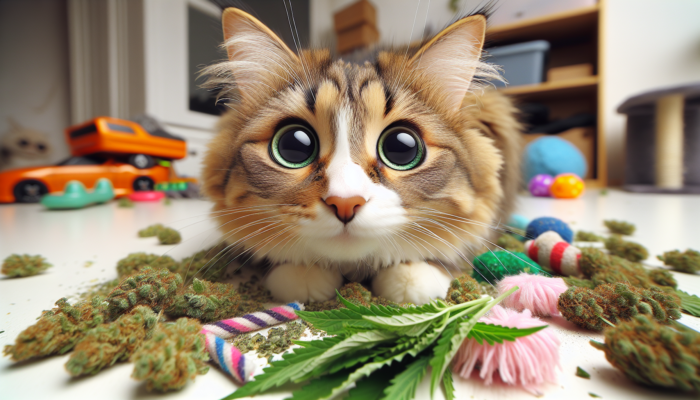Uncover the Fascinating World of Catnip: Essential Insights and Knowledge
Exploring the Unique Qualities and Benefits of Catnip
To gain a comprehensive understanding of catnip, scientifically known as Nepeta cataria, it’s essential to delve into its captivating characteristics. This resilient perennial herb belongs to the mint family and originates from the lush terrains of Europe and Asia. Remarkably adaptable, it thrives in gardens and homes across the globe. With its serrated green foliage and delicate white flowers, catnip may seem unassuming at first glance, yet it possesses extraordinary attributes that provide significant enjoyment for our feline friends.
The allure of catnip primarily stems from its essential oil, particularly the compound known as nepetalactone. When felines engage with catnip by sniffing, licking, or chewing, this compound interacts with their olfactory receptors, triggering a series of neurological responses. This often results in joyous behaviors such as rolling, purring, and playful antics, creating delightful moments that can entertain even the most stoic observers.
What about the plant itself? Catnip thrives in sunny environments and displays incredible resilience. Unlike many fragile plants, it adapts well to various soil types and environmental conditions, making it a beloved choice for both gardeners and pet owners. The leaves can be harvested and dried, preserving the herb's potent qualities for a variety of cat-related products.
Diving into the Scientific Explanation of Catnip's Effects on Cats
The scientific principles behind catnip's influence are both intriguing and multifaceted. When cats encounter catnip, the nepetalactone binds to specialized receptors in their nasal tissues, which sends signals to the brain's olfactory bulb. This interaction energizes sensory neurons, unveiling the euphoric behaviors we often observe. The effects are not fleeting; they resemble a temporary state of feline exhilaration that enchants both pets and their caregivers.
Research reveals that around 50-75% of cats respond to catnip, with this sensitivity predominantly inherited. Kittens and older cats often exhibit minimal to no reaction, as their receptors might not be fully developed or could have diminished with age. When interacting with catnip, a cat may exhibit excitement for approximately 10 to 15 minutes before typically losing interest, presenting a captivating cycle of stimulation followed by relaxation.
Interestingly, catnip is entirely safe for cats and does not pose any addiction risk. The effects are transient, and once the initial excitement subsides, felines generally revert to their usual behavior. This cycle of engagement highlights the remarkable influence of a simple herb on feline behavior, making it a fascinating subject for both pet enthusiasts and researchers alike.
Investigating the Cultural and Historical Significance of Catnip
Exploring the historical significance of catnip reveals a rich tapestry of its use across diverse cultures. Historically, catnip has provided not only entertainment for cats but also served various human purposes. The ancient Egyptians held this herb in high regard, utilizing its psychoactive properties on felines, which they considered sacred creatures. They believed that the euphoric reactions elicited by catnip were divine gifts, connecting these revered animals to their deities.
During Europe’s medieval period, catnip was recognized as a herbal remedy. Brewed into tea, it was thought to alleviate ailments such as insomnia, anxiety, and digestive issues. Herbalists acknowledged its calming effects, which remain valued in various traditional and holistic health practices today.
The history of catnip extends even further; in certain cultures, it was used to create mild sedatives, demonstrating its versatility. Today, it continues to be a popular herbal remedy, frequently appearing in teas and tinctures, further solidifying its status as an herb that transcends its playful reputation with cats.
Understanding the historical context of catnip enriches our appreciation for this extraordinary herb, highlighting its dual role as a source of joy for our feline companions and a valuable plant for human applications.
Engaging with Catnip: Observing Feline Behaviors and Reactions

Understanding the Diverse Reactions of Cats to Catnip
When examining the catnip experience, it’s crucial to acknowledge that individual feline responses can vary significantly. The behaviors triggered by catnip often differ markedly among cats. For some, it ignites an exhilarating burst of energy—a frenzied sprint across the room as if chasing invisible prey. Others may respond with gentle swaying, blissful rolling, or soothing purring that can last several minutes, creating a scene of pure feline delight.
Typically, the effects of catnip manifest within seconds of exposure, prompting cats to engage in behaviors such as rubbing their faces against the catnip, rolling in joy, and vocalizing with enthusiasm. This display is genuinely entertaining. Conversely, some cats may adopt a more relaxed posture, savoring the aroma while lounging in a tranquil state.
Interestingly, the intensity of these reactions often depends on the freshness of the catnip. Dried catnip tends to lose its potency over time, while fresher leaves are more likely to provoke a vigorous response. Additionally, many cats experience a ‘high’ that can vary in duration and intensity, often returning for more once they’ve had a chance to rest.
For cat owners, understanding their pets' responses to catnip is essential for creating a stimulating environment. Whether through toys infused with catnip or sprinkled on scratching posts, the key lies in observing your cat’s preferences and tailoring the experience to maximize their enjoyment.
Recognizing the Duration and Frequency of Catnip Effects
When navigating the world of catnip consumption, moderation is vital. The duration of effects usually lasts from 10 to 15 minutes, after which many cats will lose interest and often require a break before they can fully enjoy it again. This characteristic makes catnip an excellent tool for playtime without overwhelming your furry friend.
Regarding frequency, it's advisable to wait a couple of hours between sessions. Overexposure can dull a cat’s response, similar to any pleasurable experience. However, some cats may thrive on more frequent doses, so it's essential to monitor your cat’s unique behaviors and adjust accordingly.
Introducing catnip into your cat’s routine should be done thoughtfully. Integrating it into playtime can act as a stimulant that promotes exercise and mental engagement. Whether you sprinkle it on their favorite toy or provide a new catnip-infused scratching post, keeping the experience fresh and stimulating is crucial.
By maintaining a balanced approach to catnip use, you can ensure that your cat remains captivated by this enchanting herb, using it as a source of excitement and enjoyment rather than allowing it to become a mundane routine.
Understanding Genetic Variations in Catnip Sensitivity

One of the most captivating aspects of catnip is its varied effects on different felines. This diversity can largely be attributed to genetics. Research indicates that sensitivity to catnip is hereditary, with an estimated 50-75% of cats exhibiting some level of reaction. Kittens under six months and older cats may show little to no interest, as their receptors may not yet be developed or may have declined with age.
For those feline friends who remain indifferent to catnip, there’s no need for concern! Numerous alternatives exist to stimulate your cat’s interest and playfulness. Options such as <a href=”https://unitypets.com/catnip-reaction-unraveling-the-feline-frenzy/”>silvervine</a>, valerian root, or even honeysuckle can evoke similar reactions, introducing new avenues for fun and engagement.
Moreover, some cats may simply lack the receptors that respond to nepetalactone, rendering them unaffected by the effects of catnip. Understanding this can help cat owners appreciate their pets' individuality, ensuring that playtime remains enjoyable regardless of their reaction to this beloved herb.
Incorporating alternative stimulants into your cat’s lifestyle can enrich their environment, ensuring that every cat, regardless of their response to catnip, finds joy and excitement in play.
Integrating Catnip into Daily Life: Practical Applications and Uses
Utilizing Catnip as a Powerful Training Tool for Cats
Harnessing the delightful power of catnip for training purposes can significantly enhance your bond with your feline companion. This herb can serve as a positive reinforcement tool, encouraging desired behaviors while making the training process enjoyable for both you and your cat.
When incorporating catnip into training sessions, it's crucial to apply it strategically. For example, if you want to encourage your cat to use a scratching post instead of your furniture, sprinkling some catnip on the post can entice them, making it a more appealing choice. This method effectively redirects behaviors, fostering healthy habits while protecting your furniture.
The key is to consistently pair catnip with commands or actions. For instance, if you’re teaching your cat to come when called, rewarding them with a bit of catnip after they respond can strengthen the association between the command and the enjoyable experience of catnip, enhancing their learning process.
Additionally, incorporating catnip during playtime can facilitate positive associations. Engaging your cat with catnip-infused toys not only stimulates their mind but also strengthens your bond, creating an interactive and fun learning environment.
Discovering the Expansive Marketplace of Catnip Toys and Products
The market for catnip toys and products is brimming with creativity, offering a wide array of options to delight your feline friend. From plush toys to scratching posts infused with catnip, there are countless choices to cater to every cat’s preferences.
Investing in high-quality catnip products can elevate your cat’s playtime experience. Seek out toys stuffed with organic catnip, ensuring they are free from harmful chemicals and additives. Reputable brands prioritize quality, often using fresh catnip, which can significantly enhance your cat’s level of engagement.
Interactive toys, such as feather wands infused with catnip or puzzle feeders that dispense catnip, provide both mental stimulation and physical exercise. These products not only entertain your cat but also promote a healthy lifestyle, reducing the likelihood of boredom-related behaviors.
Moreover, don’t overlook the joy of DIY catnip toys. Simply filling a sock with catnip and sewing it shut can create a delightful, homemade toy that your cat will love. The joy of play is amplified when catnip is involved, making it an essential addition to any cat parent’s toolkit.
Creating Your Own Catnip Garden: A Feline-Friendly Paradise
Establishing a catnip garden can be a rewarding project for cat enthusiasts and their furry friends. Not only does it provide fresh catnip for your cats, but it also enhances the visual appeal of your outdoor space.
Cultivating catnip is relatively straightforward, as it thrives in various conditions. It prefers well-drained soil and plenty of sunlight, making it vital to select a sunny spot in your garden. Once planted, catnip requires minimal upkeep, making it an ideal choice for busy gardeners.
The benefits of growing your own catnip go beyond aesthetics. Fresh catnip can be harvested and dried for use in toys, treats, or simply as an enjoyable sniffing experience for your cat. This not only saves money but also guarantees that your cats indulge in high-quality, organic catnip free from pesticides and chemicals.
Additionally, a catnip garden can serve as a sensory paradise for your cat. Allowing them to explore their natural environment can stimulate their senses and provide enriching outdoor experiences. Just remember to supervise your cat while they’re outside, ensuring their safety in the garden.
Health and Safety Guidelines: Essential Considerations for Catnip Use
Ensuring Catnip is Safe for Your Beloved Feline Companion
When considering the safety of catnip, it’s important to determine whether this herb is safe for our feline companions. The short answer is yes—catnip is generally safe for cats. It is non-toxic and can be enjoyed in moderation without adverse effects.
However, as with any substance, moderation is key. Excessive amounts of catnip can lead to mild gastrointestinal upset in some cats, resulting in symptoms like vomiting or diarrhea. It’s essential to monitor your cat’s reactions and adjust the frequency of exposure as needed.
For kittens and young cats, it’s wise to wait until they are at least six months old before introducing catnip. Their sensory systems are still maturing, and early exposure may not yield noticeable effects.
In summary, catnip can be a delightful addition to your cat’s life, providing stimulation and enjoyment. When monitored carefully, catnip can be a safe and enjoyable component of your pet’s daily routine.
Identifying Signs of Catnip Overindulgence
Being aware of the signs of potential catnip overdose is crucial for any cat owner. While it’s rare for cats to overindulge to a dangerous extent, recognizing the symptoms can help ensure your pet's wellbeing.
Signs of overexposure may include excessive drooling, vomiting, or lethargy. If your cat exhibits any of these symptoms after a session with catnip, it's wise to remove the catnip and keep a close watch on them. In most cases, the effects will subside over time, and your cat will return to their usual behavior.
If symptoms persist or worsen, consulting your veterinarian is the best course of action. They can provide you with valuable guidance and support to ensure your cat remains healthy and happy.
As a precautionary measure, always limit catnip sessions to a few times a day and provide breaks to prevent overstimulation. This strategy not only keeps your cat safe but also preserves the delightful effects of catnip.
Introducing Catnip to Kittens: A Thoughtful Approach
Introducing catnip to young cats requires a mindful approach. Since kittens under six months old often lack the receptors necessary to respond to catnip, it’s best to wait until they are older.
Once your kitten reaches the appropriate age, you can gradually introduce catnip. Start with small amounts and observe their reactions. Some kittens may display curiosity and playfulness, while others might remain indifferent.
If your kitten shows interest, you can incorporate catnip into their toys or playtime. This can serve as an engaging way to stimulate them mentally and physically. However, if they show no reaction, that’s perfectly fine—there are plenty of other toys and activities that can keep them entertained.
Ultimately, the key to introducing catnip to kittens is patience and observation. Every cat is unique, and their response to catnip can vary. Embrace their individuality and discover what works best for your furry friend.
Exploring the Versatile Uses of Catnip
Unveiling the Benefits of Catnip for Human Use
While catnip is primarily recognized for its effects on felines, it also offers potential advantages for humans. Historically, catnip has been utilized in herbal medicine due to its calming properties. Brewed as a tea, it’s believed to alleviate stress, anxiety, and even insomnia, making it a gentle natural remedy for those seeking relaxation.
The calming effects of catnip can be attributed to its mild sedative properties. Some studies suggest it may help reduce anxiety and promote restful sleep. However, it’s important to note that the potency of these effects may vary from person to person.
Integrating catnip into your wellness routine can be as simple as brewing a soothing cup of catnip tea before bedtime. As with any herbal remedy, consulting with a healthcare professional before introducing it into your regimen—especially if you’re pregnant or taking medication—is advisable.
This lesser-known aspect of catnip adds another layer of appreciation for this versatile herb, illustrating its potential to benefit not just our feline friends but also humans.
Utilizing Catnip as a Natural Pest Deterrent
In addition to its appeal for cats, catnip also serves a role in natural pest control. The essential oils found in catnip contain compounds that can deter various pests, including mosquitoes and cockroaches.
Using catnip as a natural pest repellent is an eco-friendly alternative to chemical solutions. You can create a simple spray by steeping dried catnip in water and using it to mist areas prone to insects, which can be particularly beneficial in gardens, where a natural deterrent can safeguard your plants without harming the environment.
Moreover, some studies have indicated that catnip is more effective than DEET, the active ingredient in many commercial insect repellents. This makes it an appealing option for those aiming to reduce their reliance on synthetic chemicals.
Incorporating catnip into your gardening practices benefits your cats and creates a healthier, more sustainable environment for your home and outdoor spaces.
Integrating Catnip into Culinary Creations
The culinary world is gradually embracing catnip, showcasing its versatility beyond its allure for our feline friends. Although it may not be a common ingredient in mainstream cooking, catnip can add a unique flavor profile to a variety of dishes.
Beyond its role in teas, catnip can be incorporated into salads, soups, and even as a seasoning for meats. Its mild minty flavor can enhance dishes, providing a refreshing twist that surprises and delights those who experience it.
Furthermore, catnip may offer health benefits for humans, including anti-inflammatory and digestive properties. This makes it not just a flavorful addition to meals but also a functional ingredient that can contribute to overall wellbeing.
As culinary creativity continues to evolve, experimenting with catnip in recipes can be a delightful way to explore new flavors while honoring its rich history. Whether used as a garnish or a primary ingredient, catnip can add a delightful touch to your next culinary adventure.
Debunking Myths and Misunderstandings About Catnip
Clarifying Common Misconceptions Surrounding Catnip
Like many popular topics, catnip is surrounded by numerous myths and misconceptions. A prevalent myth is that all cats are affected by catnip; however, this is not accurate. As previously mentioned, only about 50-75% of cats respond to catnip, and this sensitivity is genetic.
Another misconception is that catnip functions as a drug that can harm cats. In reality














